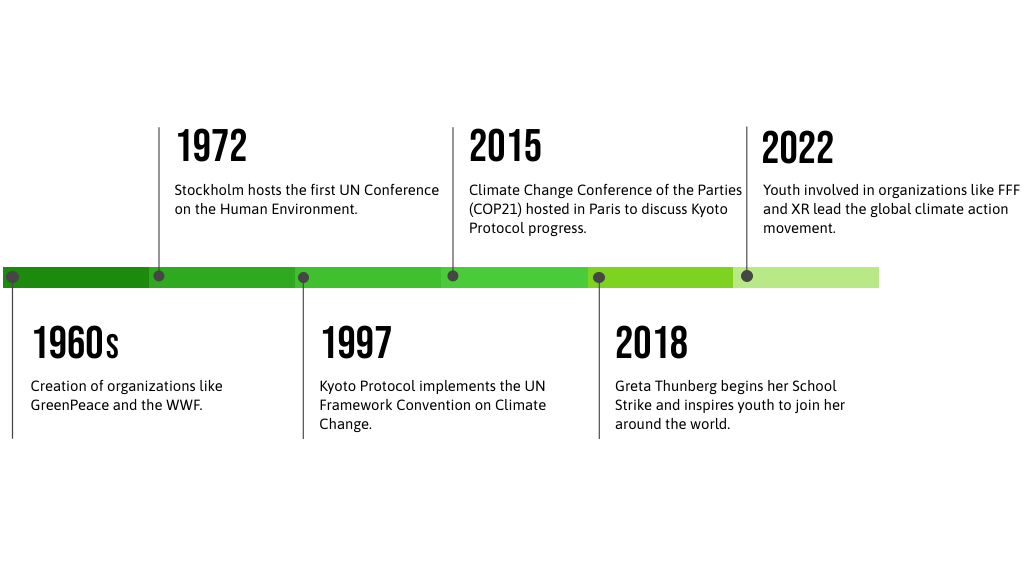The Current State of Youth Engagement in Climate Action
Throughout history, youth have been on the front lines of socio-political movements. Youth have expressed dissent and inspired their peers and communities to demand accountability from decision-makers and urge priorities to be shifted from solely economic interests to those that prioritize the needs of all people, including vulnerable populations and the earth.5 This section will provide an overview of youth’s place in the history of the environmental movement, highlight key youth climate action advocates, and explore current barriers to youth engagement in the climate action arena.
Thea de Paoli discusses her perspectives on youth climate action (1:04)
History of Environmentalism
Young people are the driving force behind today’s environmental movement. This, however, has not always been the case. The prominence of youth in advocating for environmental protection and fighting for action to mitigate the climate crisis is relatively recent in the long history of environmental activism, partly due to the increasing severity of climate change.
Rachel Carson’s book, The Silent Spring (1962), is widely seen as the catalyst to modern-day environmentalism. Her book explores the devastating environmental impacts of indiscriminate synthetic pesticide use.19 It epitomized the new concerns of the environmental movement, which emerged in the 1960s and can be seen as a reaction to environmental harm caused by pollution from anthropogenic activity.19 The 1960s gave rise to activist culture, which saw young people, in particular, taking direct action to fight against injustices in their society, including environmental injustices.20 Soon, environmental groups and NGOs began to crop up all over North America. Greenpeace, for example, was founded in Vancouver in 1971 in opposition to nuclear testing and has today become one of the most prominent environmental NGOs in the world, tackling a wide range of issues related to fighting climate change.21 These groups supported a wide range of environmental and geopolitical issues, from pollution to the use of nuclear weapons and power.
The culmination of this was the United Nations Conference on the Human Environment in 1972; the first global conference focused on environmental issues. This spurred the development of international environmental policy-making and advocacy, leading to the development of non-governmental organizations (NGOs) and subsequent international events concerning climate-related matters.22 By the turn of the 21st Century, climate change had become a major concern for activists and politicians alike. The adoption of the Kyoto Protocol in 1997 secured climate change as a global concern, requiring nations to reduce greenhouse gas (GHG) emissions by a designated amount.21 Notoriously, the United States did not ratify the agreement, and Canada withdrew in 2011 under Stephen Harper, leading many to question the efficacy of international agreements on climate change.23 In the 20-odd years since the Kyoto Protocol, many more international conferences focused on climate change have occurred, such as the 2015 Paris Climate Change Conference (COP 21), which set the target of limiting global warming to 1.5°C.24
While many international agreements have been ratified and numerous federal policies enacted, climate change is still a significant concern, especially among today’s youth, who are becoming increasingly concerned with the risks posed to their futures by the ongoing climate crisis. This is partly due to the growing body of scientific evidence for anthropogenic climate change paired with increased media attention on social platforms.25 Prior to the United Nations’ 11th annual Conference of the Parties (COP 11), hosted in Montreal, a group of young people from around the world met at the first Conference of Youth (COY).21 According to the UNFCCC, the annual COY aims to “empower youth and formally bring their voices to the UNFCCC processes to shape the intergovernmental climate change policies,” and continues to bring groups of young people together every year to participate in discourse on policy development and climate action.26
In recent years, youth involvement in climate activism has transformed from more structured involvement within international conventions like the UNFCCC to more grassroots movements led and organized by youth worldwide.25 Examples include Fridays For Future (FFF) and Extinction Rebellion (XR), both newer movements spearheaded by today’s youth. Extinction Rebellion has focused its efforts on employing acts of “nonviolent civil disobedience”, such as blocking off heavily trafficked bridges to pressure governments to act before reaching environmental tipping points related to ecosystem disruption and destruction.27 Fridays for Future was inspired by Greta Thunberg, a 19-year-old Swedish climate activist. It transformed into a global movement of youth demanding urgent action on the climate crisis by skipping classes on Fridays to protest global leaders who continue to invest money in fossil fuels rather than transitioning to renewable energy sources.28 These two movements are powerful examples of how youth have taken the lead in the fight against climate change and, in many ways, hold the future of our world in their hands.


